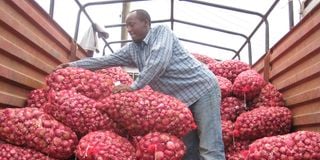Premium
Cutting losses after harvesting onions

A trader unloads onions to sell. Following good practices like crop rotation, timely weeding and appropriate use of fertiliser can improve the quality and yield of onions.
One of the main challenges farmers face is post-harvest loss.
This happens when transporting and storing produce.
Losses usually start on the farm during harvesting or when carrying out management practices.
Reducing post-harvest loss is a reasonable step towards food security.
Today, we look at post-harvest management practices of onions and the mitigation measures taken by farmer Desmond.
As a farmer, it is good to sell the onions immediately after harvest. This, however, is not always possible due to fluctuations in prices and proximity to the market.
The onion farmer, therefore, needs adequate skills to handle the produce while carrying out management practices, harvesting, transport and storage.
The quality of the planting materials can play a part in post-harvest losses. Poor-quality seeds produce onions that are vulnerable to damage and disease.
In addition, bacterial and fungi infections can develop while food is being grown and stored.
Infections may be the cause of rotting and discolouration in onions. Onions can also be damaged and become susceptible to infection and spoilage if eaten by insects, thrips, mites, maggots and other pests.
It is important to take precautions and avoid bacterial and fungal infections, as well as insect and pest damage.
This may entail using fungicides and pesticides as well as carefully inspecting and sorting onions to get rid of contaminated or damaged ones.
Harvesting of immature onions reduces their shelf-life. Such onions go bad or sprout easily.
Inadequate curing also influences post-harvest losses at farm level.
Extreme weather like heavy rain or a lot of sun can damage the crop.
Too much rain, for instance, causes onions to rot, while too much sun may result in scalding – a physiological disorder that results in a whitish colour on the outer layer of the onions, rendering them unmarketable.
Mechanical damage during harvesting, handling and transport also results in potential losses.
The rough handling can cause bruising, cuts and damage to the outer layer of the onion, making it more susceptible to decay and spoilage.
Onions should, therefore, be handled with care during harvesting and storage. They should be stored and transported in appropriate containers to minimise damage.
Onions should be stored in a cool, dry and well-ventilated area to prevent sprouting, rotting and moulding.
High humidity and warm temperature can cause sprouting, while low humidity leads to drying and shrivelling.
Following good practices like crop rotation, timely weeding and appropriate use of fertiliser can improve the quality and harvest of onions.
The harvested onions should be kept in a clean and disinfected room to prevent fungal infections.
Farmers who take appropriate measures to manage post-harvest losses in onions have increased profits.
That also helps improve the country’s food security.
In our next article, we will look at returns on investment in onion production.




